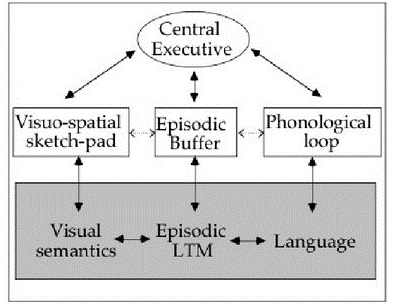Stress can be chronic or acute. They both induce chemical changes in the body and brain. Excess stress – chronic or acute – both adversely affect memory function (working memory and long term memory), especially the explicit or declarative long-term memory. The level of stress hormones increase upon exposure to extrinsic or intrinsic stress. The part of the brain that was found to be affected by stress hormones are the hippocampus, prefrontal cortex and the amygdala – all of which are important and involved in memory function. Cortisol (or Hydrocortisone) is the stress hormone produced in the body during stress. It belongs to a group of steroid hormone known as glucocorticoid produced by adrenal cortex. Mild stress does not appear to severely impair memory probably because of body’s natural defense response under stress. The release of cortisol in stress response also activates anti-stress and anti-inflammatory pathways which may mitigate the potential adverse effects on health including memory and cognitive functions. The effect of stress on memory has been implicated to be an inverted U shaped effect. Cortisol was found as a common mediating mechanism for both the facilitating and impairing effects of stress during different memory phases. The difference in effect may be due to how cortisol impacts glucocorticoid receptors in the hippocampus and prefrontal cortex.
Effect of Acute Stress
When does stress facilitate memorization instead of impairing it? The stress will only facilitate memorization when the stress is originated in the context and around the time of event that needs to be remembered and when the stress hormones and neurotransmitters (some stress hormones are neurotransmitters themselves) activate the same circuits as those activated by the situation. The more relevant the context in which stress is experienced, the easier the events will be hard encoded by brain. Enhanced memories resulting from stressful learning situations can be due to the effect of stress on memory acquisition and consolidation phase through enhancing attention, sensory perception, motor function.
Is there a difference for extrinsic or intrinsic stress in terms of their effect on memory? It is hypothesized that intrinsic (psychological)stress facilitates learning and memory processes whereas extrinsic stress normally will impair memorization or memory retrieval. Some intrinsic stress tend to enhance memory consolidation. But the role of extrinsic stress in memory consolidation seems to be quite heterogeneous. The controllability and predictability of the stressors make a difference. Uncontrolled stressors tend to be more deleterious.
Is there different effects for different memorization phases ? Based on the review of results presented in the scientific literatures, scientists has proposed the opposing effects by stress. Stress appear to facilitate memory consolidation while impair the retrieval of information, but only generally. Acute extrinsic stress has been revealed to be more efficient to disturb memory retrieval.
Is there different effects on the type of things to be remembered (types of memory)? Whether it is declarative implicit memory or nondeclarative explicit memory? It appears that declarative memory is more vulnerable to stressors. Studies has shown that both intrinsic and extrinsic stress enhances classical conditioning (a type of nondelarative implicit memory; see post “examples of Examples And Types of Nondeclarative Implicit Memory). But experiencing an acute, highly stressful external event can interfere with retrieval of previously stored declarative memory (facts, events, knowledge).
Effect of Chronic Stress
Chronic stress occurs when the body experience stressors (environmental or psychological) with sustained frequency and intensity to such an extent that the body’s natural anti-stress (relaxation) response can not be activated or be suppressed. Chronic stress induce what is know as fight-or-flight response during which stress hormone epinephrine (or adrenalin) and norepinephrine (or noradrenaline) are produced by adrenal along with other hormones such as cortisol. Epinephrine and norepinephrine are not only hormones but also neurotransmitters belong to the categories of neurotransmitter known as catecholamine. Other member of catecholamine include dopamine. Epinephrine, norepinephrine and dopamine comprise the most abundant catecholamine in the human body. Moderate level of epinephrine is actually positive for memory function, it has been found to help create the type of autobiographical long term memory known as flashbulb memory.
Chronic high intensity stressors seem to facilitate classical conditioning whereas it impairs explicit declarative memory. Hippocampus was the main target of cortisol.Cortisol has been found to shrink the size of hippocampus – the central unit of the brain that transfer short-term memory to long-term storage for later retrieval. It is not yet known whether this shrinking is reversible. It is believed that structural and molecular alternations induced by chronic stress in this brain area account for impairment of hippocampus dependent memory types i.e explicit declarative memory (episodic and semantic memory). Stress induced high glucocorticoid levels can suppress neurogenesis in the dentate gyrus and compromise neuron survival.
Increasing evidence suggests parallel alternations in the prefrontal lobe as well – a region of brain important for working memory function induced by chronic stress. Major neuronal structural alteration occurs in the medial part as a consequence of chronic stress or prolonged treatment of glucocorticoid in vitro including dendritic atrophy. Prefrontal cortex is very sensitive to changes in the neuromodulatory inputs it receives from norepinephrine (NE) and dopamine (DA) systems and that this sensitivity can result in marked alteration in the working memory functions of the PFC. Very high levels of catecholamine release during exposure to uncontrollable stress disrupt the cognitive functions of prefrontal cortex.


